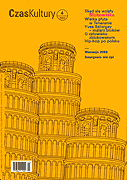Jak komercjalizuje się hip-hop
The Commercialisation of Hip-Hop
Author(s): Andrzej BudaSubject(s): Cultural Essay, Political Essay, Societal Essay
Published by: Stowarzyszenie Czasu Kultury
Keywords: 1990’s: a negative response to hip-hop in Poland; Graffiti and break-dance; Commercial success of Polish hip-hop Saturation of the music market with hip-hop
Summary/Abstract: At the beginning of the 1990’s people believed that hip-hop, being a specifically American product, would not assimilate to Polish conditions. Several years later this turned out to be completely wrong. The surprised media did not know how to react to this wave of new sounds and quickly decided to assume a negative approach to the spectacular success of Liroy who had sold half a million albums and was a completely new phenomenon in the music market. The verdict, or rather definition was: rap is synonymous to singing vulgar words and stealing ideas from other musicians; it is the music of gangsters. Andrzej Buda stresses that hip-hop means more than just rapping and bass-lines. It is also the art of bringing colour to dull places by means of graffiti (which is already influencing advertising agencies in Warsaw) as well as dance (break-dancing now has its own annual festival in Poland, Battle of the Year). Nevertheless, only the first of these aspects can boast real commercial success to which important record labels, festivals sponsored by the television and clothes manufacturers have contributed significantly. At present the music market is becoming saturated. After the mass wave of hip-hop releases between 2000 and 2002 we are currently observing a stagnation which is particularly unfavourable to those who are new to the market. Even the release of the most popular Polish hip-hop album to date, Na legalu by Peja/SLUMS ATTACK was done very hastily. It was released in 2001 to coincide with the heated public debate about Sylwester Latkowski’s controversial film Blokersi as well as to meet the needs of the changing music market which reflects the growing diversification of styles and types of hip-hop fans.
Journal: Czas Kultury
- Issue Year: 2003
- Issue No: 04
- Page Range: 053-060
- Page Count: 8
- Language: Polish
- Content File-PDF

